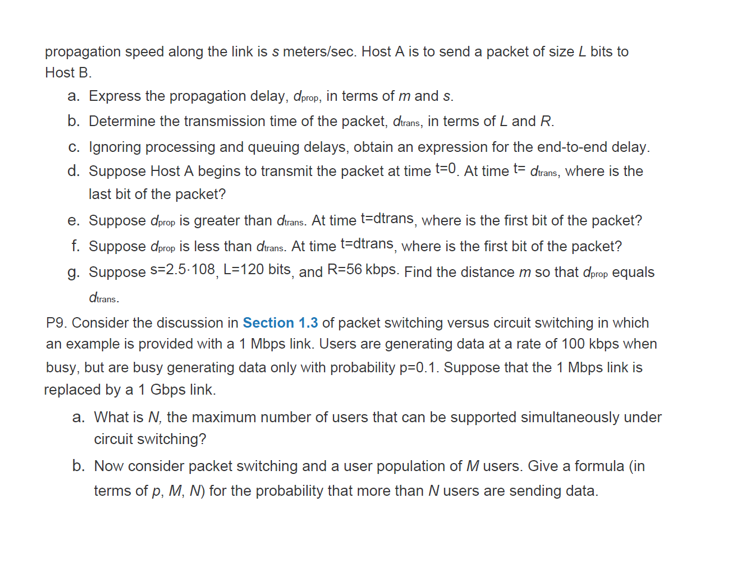Answered step by step
Verified Expert Solution
Question
1 Approved Answer
Remember that 1 Mbps is 106 bits per second (not bytes per second). Problems: Solve the following problems from the textbook, 7th edition (Note:


Remember that 1 Mbps is 106 bits per second (not bytes per second). Problems: Solve the following problems from the textbook, 7th edition (Note: The problems in other editions are different, so make sure you obtain the problems from the 7th edition) P2, P5, P6, P9. (Since some of you might have a different version of the book, I include the assigned HW problems from the textbook for your convenience.) P2. Equation 1.1 gives a formula for the end-to-end delay of sending one packet of length L over N links of transmission rate R. Generalize this formula for sending P such packets back-to- back over the N links. P5. Review the car-caravan analogy in Section 1.4. Assume a propagation speed of 100 km/hour. a. Suppose the caravan travels 150 km, beginning in front of one tollbooth, passing through a second tollbooth, and finishing just after a third tollbooth. What is the end-to-end delay? b. Repeat (a), now assuming that there are eight cars in the caravan instead of ten. P6. This elementary problem begins to explore propagation delay and transmission delay, two central concepts in data networking. Consider two hosts, A and B, connected by a single link of rate R bps. Suppose that the two hosts are separated by m meters, and suppose the propagation speed along the link is s meters/sec. Host A is to send a packet of size L bits to Host B. a. Express the propagation delay, dprop, in terms of m and s. b. Determine the transmission time of the packet, dtrans, in terms of L and R. c. Ignoring processing and queuing delays, obtain an expression for the end-to-end delay. d. Suppose Host A begins to transmit the packet at time t=0. At time t= dirans, where is the last bit of the packet? e. Suppose dprop is greater than dirans. At time t=dtrans, where is the first bit of the packet? f. Suppose dprop is less than dirans. At time t=dtrans, where is the first bit of the packet? g. Suppose s=2.5-108, L=120 bits, and R=56 kbps. Find the distance m so that dprop equals dtrans. P9. Consider the discussion in Section 1.3 of packet switching versus circuit switching in which an example is provided with a 1 Mbps link. Users are generating data at a rate of 100 kbps when busy, but are busy generating data only with probability p=0.1. Suppose that the 1 Mbps link is replaced by a 1 Gbps link. a. What is N, the maximum number of users that can be supported simultaneously under circuit switching? b. Now consider packet switching and a user population of M users. Give a formula (in terms of p, M, N) for the probability that more than N users are sending data.
Step by Step Solution
There are 3 Steps involved in it
Step: 1

Get Instant Access to Expert-Tailored Solutions
See step-by-step solutions with expert insights and AI powered tools for academic success
Step: 2

Step: 3

Ace Your Homework with AI
Get the answers you need in no time with our AI-driven, step-by-step assistance
Get Started


